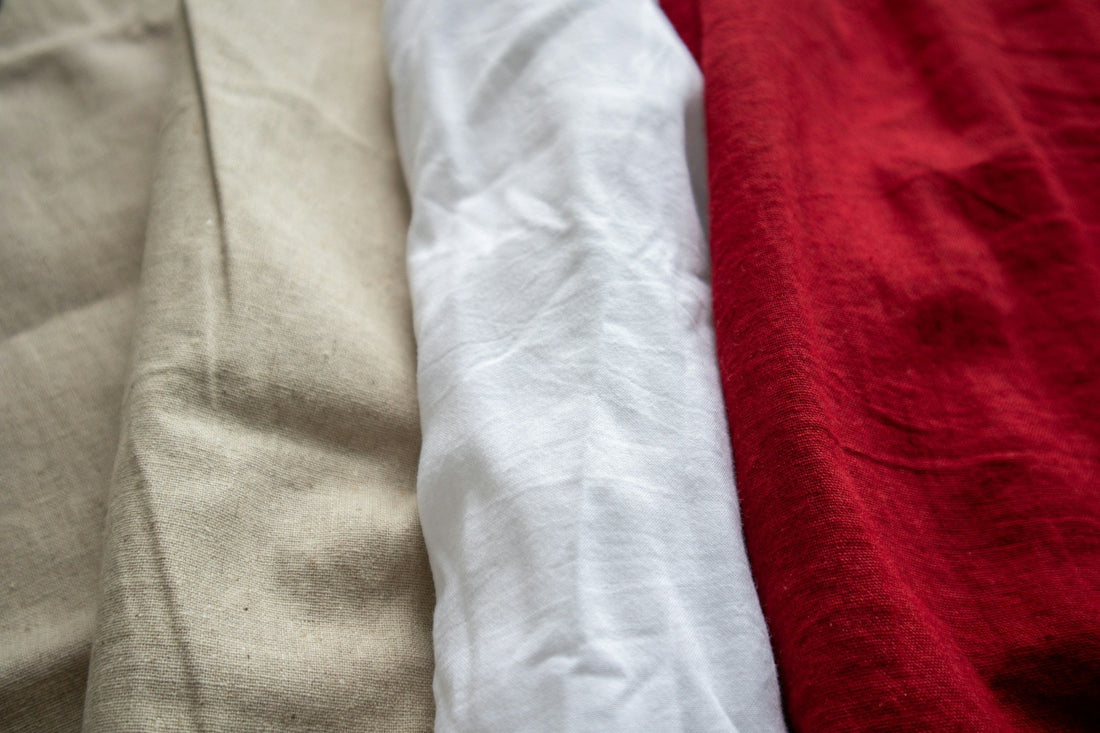
The History of Linen
Share
Linen is one of the oldest textiles known to humanity, with roots stretching back thousands of years. Among the many fabrics used by the Vikings during the Viking Age (c. 793–1066 AD), linen held a vital place—not only in clothing but also in everyday life and even seafaring. This article explores the history of linen and details how Vikings made this durable and versatile fabric, grounded in archaeological and historical evidence.
The Origins of Linen

Ancient Egypt - papyrus, people wearing tunics made of linen
Linen is a fabric made from fibers of the flax plant (Linum usitatissimum), which humans have cultivated for over 8,000 years. Ancient civilizations such as those in Egypt and Mesopotamia used linen extensively for clothing, burial shrouds, and household textiles. By the Viking Age, flax cultivation and linen production had spread across Europe, including Scandinavia.
Linen and Viking Scandinavia
The Vikings were skilled farmers and artisans, and flax cultivation was well established in their communities. Archaeological digs in Viking-age sites across Denmark, Sweden, Norway, and Iceland have uncovered flax seeds, retting pits, loom weights, spindles, and textile fragments—evidence of linen’s importance.
For example, at the Viking settlement of Hedeby (in modern-day Germany but part of the Viking world), archaeologists found numerous loom weights and flax seeds, indicating large-scale linen production (Bender Jørgensen, 1992). Similarly, textile fragments from Birka in Sweden and Ribe in Denmark confirm that linen was a common fabric in Viking clothing.
Linen was prized for its:
· Durability: Linen fibers are among the strongest natural fibers, making linen garments last longer in harsh climates.
· Comfort: Linen breathes well, keeping the wearer cooler in summer and warmer when layered.
· Utility: Beyond clothing, linen was used for sails, ropes, and household textiles.
How Was Linen Made in Viking Times?
The process of turning flax into linen was labor-intensive and required significant skill and time. Vikings followed a series of steps—many of which have been reconstructed through archaeological findings and ethnographic studies of traditional flax processing in Northern Europe.

Flax plant
1. Cultivating and Harvesting Flax
Flax was grown in fields during the spring and summer. Harvesting took place when the plant’s stalks turned golden but before the seeds fully hardened, typically in late summer. Viking farmers pulled the flax plants by the roots to preserve the full length of fibers.
2. Retting
After harvesting, the flax stalks underwent retting—a microbial process where stalks were soaked in water (such as rivers, ponds, or specially prepared retting pits) for about 1 to 2 weeks. Retting breaks down the pectin that binds fibers to the woody core, allowing the fibers to be separated later. Archaeological evidence shows that Viking communities used natural water sources for retting, sometimes protected by wooden enclosures to keep flax submerged.
3. Breaking
Once retted and dried, flax stalks were crushed with wooden mallets on a stone or wooden surface. This “breaking” crushed the woody core into small pieces without damaging the valuable fibers.
4. Scutching
After breaking, the crushed flax was scutched—scraped or beaten with a wooden blade to remove broken woody pieces, leaving the softer fibers intact. Archaeological finds of scutching knives from Viking sites support this step.
5. Heckling (Combing)
The flax fibers were combed through a bed of sharp wooden or metal spikes called a heckle to separate the long fibers (line flax) from the short fibers (tow). This step also straightened the fibers and prepared them for spinning.
6. Spinning
Viking spinners used drop spindles to twist the flax fibers into yarn. Spindle whorls found in Viking archaeological sites vary in size, indicating spinning of different yarn thicknesses for various textile uses.
7. Weaving
The yarn was woven on warp-weighted looms, the predominant type in Viking Scandinavia. Loom weights found at sites like Birka and Hedeby help archaeologists reconstruct Viking weaving techniques. Linen cloth could be finely woven for clothing or more coarsely woven for household use.
8. Finishing
The woven linen might be bleached or dyed with natural dyes, or left in its natural off-white color. Viking textile fragments show evidence of plant-based dyes, though many linen garments were probably undyed.
Linen’s Role in Viking Society

Vikings, gathered around the fire, historical recreation
Linen was fundamental in Viking daily life. Men and women wore linen tunics and undergarments, often layered under wool garments for warmth. Linen was also used for curtains, bags, and sailcloth. The durability and breathability of linen made it indispensable for both everyday wear and long voyages.
In fact, the Vikings’ ability to build sturdy ships and sail across the North Atlantic was partly due to linen sails—woven from flax grown and processed by their own hands.
